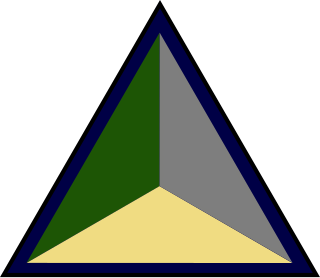Related Research Articles

The 52nd (Lowland) Infantry Division was an infantry division of the British Army that was originally formed as the Lowland Division, in 1908 as part of the Territorial Force. It later became the 52nd (Lowland) Division in 1915. The 52nd (Lowland) Division fought in the First World War before being disbanded, with the rest of the Territorial Force, in 1920.

The 56th (London) Infantry Division was a Territorial Army infantry division of the British Army, which served under several different titles and designations. The division served in the trenches of the Western Front during the First World War. Demobilised after the war, the division was reformed in 1920 and saw active service again in the Second World War in Tunisia and Italy. The division was again disbanded in 1946 and reformed first as an armoured formation and then as an infantry division before final disbandment in 1961.
The 20th Independent Infantry Brigade was an infantry brigade of the British Army, raised during the Second World War.

The Guards Division was an infantry division of the British Army that was formed in the Great War in France in 1915 from battalions of the Guards regiments from the Regular Army. The division served on the Western Front for the duration of the First World War. The division's insignia was the "All Seeing Eye".

The 301st Infantry Brigade was a formation of the British Army organised from surplus Royal Artillery (RA) personnel retrained as infantry towards the end of the Second World War.
The 303rd Infantry Brigade was a formation of the British Army organised from surplus Royal Artillery (RA) personnel retrained as infantry towards the end of the Second World War.

The 304th Infantry Brigade was a formation of the British Army organised from surplus Royal Artillery (RA) personnel retrained as infantry towards the end of the Second World War.
The 305th Infantry Brigade was a formation of the British Army organised from surplus Royal Artillery (RA) personnel retrained as infantry towards the end of the Second World War.
306th Infantry Brigade was a British Army formation organised towards the end of the Second World War from surplus Royal Artillery (RA) personnel who had been retrained as infantry.
307th Infantry Brigade was a formation of the British Army organised from surplus Royal Artillery (RA) personnel retrained as infantry towards the end of the Second World War.
308th Infantry Brigade was a formation of the British Army organised from surplus Royal Artillery (RA) personnel retrained as infantry towards the end of the Second World War.

204th Independent Infantry Brigade (Home) was a Home Defence formation of the British Army during the Second World War.
The 202nd Independent Infantry Brigade (Home) was a short-lived Home Defence formation of the British Army during the Second World War.
The 221st Independent Infantry Brigade (Home) was a short-lived Home Defence formation of the British Army during the Second World War.
The 224th Brigade was a Home Defence formation of the British Army in the First and the Second World Wars. It existed under several variations of the 224th Brigade title.
The North Midland (Staffordshire) Heavy Battery was a Territorial Force (TF) unit of the Royal Garrison Artillery (RGA) formed in Staffordshire in 1908. It fought on the Western Front during World War I. Converted to medium artillery in the 1920s, the unit took part in the Battle of France and Dunkirk Evacuation in the early part of World War II, before returning to action in North Africa and Italy, and finally in North West Europe.
59th Army Group Royal Artillery was an artillery formation of the British Army in World War II. Having operated in the North West Europe theatre in late 1944, it was switched to India to command artillery units preparing for the liberation of South-East Asia.

The 1st Ayrshire and Galloway Artillery Volunteer Corps was formed in 1859 as a response to a French invasion threat. It transferred to the Territorial Force (TF) in 1908 and Its successor units fought with the 52nd (Lowland) Infantry Division in Palestine during World War I, and in North West Europe and Burma during World War II. It continued in the Territorial Army (TA) until amalgamation in 1967.

The 118th Light Anti-Aircraft Regiment, Royal Artillery, was an air defence unit of the British Army during World War II. Initially raised as an infantry battalion of the Gloucestershire Regiment in 1940, it transferred to the Royal Artillery in 1942. It served in Home Forces and then went to Assam to defend Fourteenth Army's vital bases and airfields during the Burma Campaign until it was broken up in 1944.

The 102nd Light Anti-Aircraft Regiment, Royal Artillery, was an air defence unit of the British Army during World War II. Initially raised as an infantry battalion of the Lincolnshire Regiment in 1940, it transferred to the Royal Artillery in 1941. It served with I Corps in the campaign in North West Europe, at times acting as infantry or administrative troops when the threat of air attack had diminished. It was disbanded after the war.
References
- Lionel Ellis, "History of the Second World War: United Kingdom Military Series: Victory in the West", Volume II: "The Defeat of Germany", London: HMSO, 1968/Uckfield: Naval & Military, 2004, ISBN 1-84574-059-9.
- Joslen, H. F. (2003) [1990]. Orders of Battle: Second World War, 1939–1945. Uckfield: Naval and Military Press. ISBN 978-1-84342-474-1.